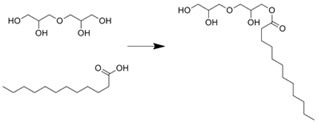Table 4.
The use of enzyme-immobilized microreactors for hydrolysis and esterification.
| Immobilization technique | Enzyme | Reaction scheme | Results | Ref. |
|---|---|---|---|---|
| Surface modification of silica capillary by sol-gel technique/immobilized through amide bond formation using succinate linker | Lipase |  |
1.5 time better yield was obtained compared with batchwise reaction | [45] |
| Entrapment within folded-sheet mesoporous silicas | Lipase |  |
Reaction yield was 10 time higher than batchwise reaction | [63] |
| Covalently immobilized in silica micro structured fiber | Lipase |  |
Almost complete conversion of a vegetable oil to monoacylglycerol | [64] |
| Entrapment of Novozym-435TM within microchannel | Lipase |  |
Much less of the reactant was required compared with the batchwise test | [65] |
| Ni-NTA agarose bead immobilization | p-Nitrobenzyl esterase |  |
80% yields were obtained along with traces of byproduct | [28] |
| Silica monolith entrapped within microchannels | Protease P |  |
Conversion within microreactor was higher than that of the batchwise reaction at higher flow rates | [33] |
| Silica monolith entrapped within microchannels | Lipase |  |
Optical resolution of products was achieved by connecting commercially available chiral column | [35] |
| Membrane formation with paraformaldehyde, glutaraldehyde, and poly-Lys | α-Amino-acylase |  |
Optical resolution of d/l-amino acids were achieved by connecting to micro solvent extractor | [60] |
